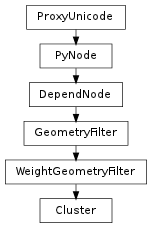pymel.core.nodetypes.Cluster¶

- class Cluster(*args, **kwargs)¶
class counterpart of mel function cluster
The cluster command creates a cluster or edits the membership of an existing cluster. The command returns the name of the cluster node upon creation of a new cluster. After creating a cluster, the cluster’s weights can be modified using the percent command or the set editor window.
- after(val=True, **kwargs)¶
If the default behavior for insertion/appending into/onto the existing chain is not what you want then you can use this flag to force the command to stick the deformer node after the selected node in the chain even if a new geometry shape has to be created in order to do so. Works in create mode (and edit mode if the deformer has no geometry added yet).
Derived from mel command maya.cmds.cluster
- afterReference(val=True, **kwargs)¶
The -afterReference flag is used to specify deformer ordering in a hybrid way that choses between -before and -after automatically. If the geometry being deformed is referenced then -after mode is used in adding the new deformer otherwise -before mode is used. The net effect when using -afterReference to build deformer chains is that internal shape nodes in the deformer chain will only appear at reference file boundaries, leading to lightweight deformer networks that may be more amicable to reference swapping.
Derived from mel command maya.cmds.cluster
- before(val=True, **kwargs)¶
If the default behavior for insertion/appending into/onto the existing chain is not what you want then you can use this flag to force the command to stick the deformer node before the selected node in the chain even if a new geometry shape has to be created in order to do so. Works in create mode (and edit mode if the deformer has no geometry added yet).
Derived from mel command maya.cmds.cluster
- frontOfChain(val=True, **kwargs)¶
This command is used to specify that the new deformer node should be placed ahead (upstream) of existing deformer and skin nodes in the shape’s history (but not ahead of existing tweak nodes). The input to the deformer will be the upstream shape rather than the visible downstream shape, so the behavior of this flag is the most intuitive if the downstream deformers are in their reset (hasNoEffect) position when the new deformer is added. Works in create mode (and edit mode if the deformer has no geometry added yet).
Derived from mel command maya.cmds.cluster
- getDeformerTools(**kwargs)¶
Returns the name of the deformer tool objects (if any) as string string ...
Derived from mel command maya.cmds.cluster
- getExclusive(**kwargs)¶
Puts the deformation set in a deform partition.
Derived from mel command maya.cmds.cluster
- getGeometry(**kwargs)¶
The specified object will be added to the list of objects being deformed by this deformer object, unless the -rm flag is also specified. When queried, this flag returns string string string ...
Derived from mel command maya.cmds.cluster
- getGeometryIndices(**kwargs)¶
Complements the -geometry flag in query mode. Returns the multi index of each geometry.
Derived from mel command maya.cmds.cluster
- getWeightedNode(**kwargs)¶
Transform node in the DAG above the cluster to which all percents are applied. The second DAGobject specifies the descendent of the first DAGobject from where the transformation matrix is evaluated. Default is the cluster handle.
Derived from mel command maya.cmds.cluster
- parallel(val=True, **kwargs)¶
Inserts the new deformer in a parallel chain to any existing deformers in the history of the object. A blendShape is inserted to blend the parallel results together. Works in create mode (and edit mode if the deformer has no geometry added yet).
Derived from mel command maya.cmds.cluster
- prune(val=True, **kwargs)¶
Removes any points not being deformed by the deformer in its current configuration from the deformer set.
Derived from mel command maya.cmds.cluster
- remove(val=True, **kwargs)¶
Specifies that objects listed after the -g flag should be removed from this deformer.
Derived from mel command maya.cmds.cluster
- resetGeometry(val=True, **kwargs)¶
Reset the geometry matrices for the objects being deformed by the cluster. This flag is used to get rid of undesirable effects that happen if you scale an object that is deformed by a cluster.Flag can appear in Create mode of commandFlag can have multiple arguments, passed either as a tuple or a list.
Derived from mel command maya.cmds.cluster
- setGeometry(val=True, **kwargs)¶
The specified object will be added to the list of objects being deformed by this deformer object, unless the -rm flag is also specified. When queried, this flag returns string string string ...
Derived from mel command maya.cmds.cluster
- setWeightedNode(val=True, **kwargs)¶
Transform node in the DAG above the cluster to which all percents are applied. The second DAGobject specifies the descendent of the first DAGobject from where the transformation matrix is evaluated. Default is the cluster handle.
Derived from mel command maya.cmds.cluster